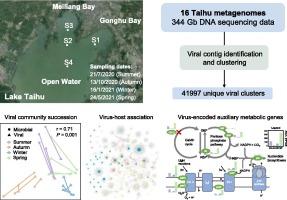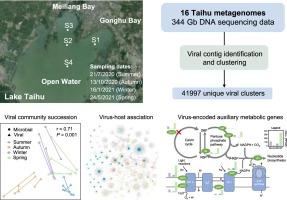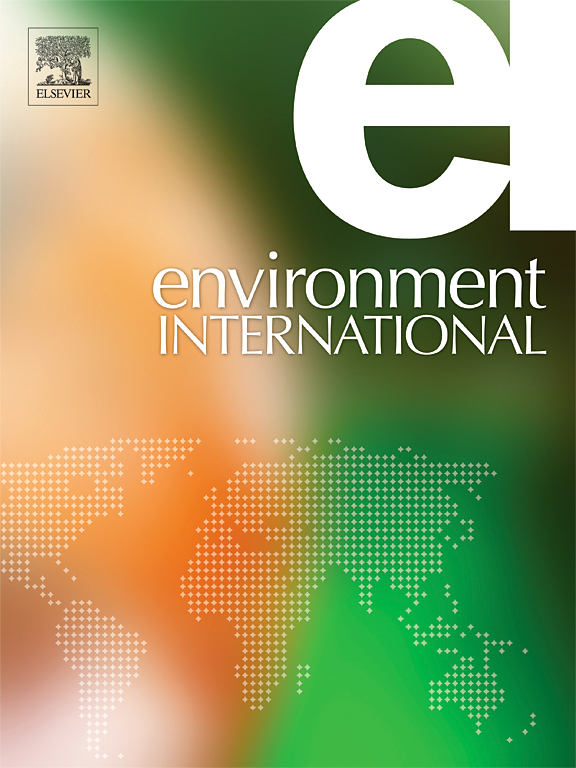饱受蓝藻水华困扰的富营养化湖泊中水生病毒的季节演替、宿主关联和生化作用
IF 10.3
1区 环境科学与生态学
Q1 ENVIRONMENTAL SCIENCES
引用次数: 0
摘要
病毒是淡水生态系统中重要的生物地球化学媒介和生态驱动因素。然而,在富营养化淡水生态系统中,病毒与宿主的关系在不同季节和水华期的动态变化仍然难以捉摸。中国太湖是一个大型富营养化湖泊,每年都会发生以微囊藻为主的有害藻华(HABs),我们从太湖浮游生物群的水体微生物组中恢复了 41,997 个独特的病毒簇,其分类范围很广,包括 15,139 个以细菌为目标的 Caudovirales 簇和 1,044 个以真核生物为目标的 NCLDV 簇。病毒群落在微生物群落(主要是蓝细菌和扁囊菌)和环境因素(主要是营养物质和温度)的驱动下呈现出明显的季节性演替。宿主预测突出表明,病毒对细菌驱动的氮途径的影响比磷酸盐循环对感染的影响更为明显。HAB 引发的微生物和环境变化影响了病毒的策略,包括生活方式、宿主范围和病毒编码的辅助代谢基因(vAMGs)分布。在夏季 HAB 高峰期,感染变形菌和放线菌的病毒表现出更强的溶菌生活方式和更集中的宿主范围,而感染类杆菌的病毒则选择了相反的策略。值得注意的是,在春季 HAB 爆发之前,vAMGs 的数量最多,它们补偿了宿主细菌的新陈代谢,包括碳水化合物代谢、光合作用和磷酸盐调节。病毒、宿主微生物和藻华相关环境之间关系的阐明表明,病毒在富营养化淡水生态系统中发挥着重要的生化作用。本文章由计算机程序翻译,如有差异,请以英文原文为准。


Seasonal succession, host associations, and biochemical roles of aquatic viruses in a eutrophic lake plagued by cyanobacterial blooms
Viruses are implicated to play key roles as biogeochemical mediators and ecological drivers in freshwater ecosystems. However, the dynamics of viruses and host associations throughout the seasons and during blooming periods in eutrophic freshwater ecosystems remain poorly understood. From the water microbiomes of planktonic biomass from Lake Taihu, a large eutrophic freshwater lake in China that experiences annual Microcystis-dominated harmful algal blooms (HABs), we recovered 41,997 unique viral clusters spanning a wide taxonomic range, including 15,139 Caudovirales clusters targeting bacteria and 1,044 NCLDV clusters targeting eukaryotes. The viral community exhibited clear seasonal succession, driven primarily by microbial communities (particularly Cyanobacteria and Planctomycetes) and environmental factors (mainly nutrients and temperature). Host prediction revealed that viral infection had a more distinct impact on bacteria-driven nitrogen pathways than on phosphate cycling. HAB-induced variations in microbial composition and environmental conditions affected viral strategies including viral lifestyles, host range, and virus-encoded auxiliary metabolic genes (vAMGs) distributions. Viruses infecting Proteobacteria and Actinobacteria showed an enhanced lysogenic lifestyle and a narrower host range during HAB peak in summer, while viruses infecting Bacteroidota adopted an opposite strategy. Notably, vAMGs were most abundant before the HAB outbreak in spring, compensating for bacterial metabolic processes of their hosts such as carbohydrates metabolism, photosynthesis, and phosphate regulation. The findings highlight the intricate relationships between viruses, host microbes, and the bloom-associated environment, underscoring the important biochemical roles viruses play in eutrophic freshwater ecosystems.
求助全文
通过发布文献求助,成功后即可免费获取论文全文。
去求助
来源期刊

Environment International
环境科学-环境科学
CiteScore
21.90
自引率
3.40%
发文量
734
审稿时长
2.8 months
期刊介绍:
Environmental Health publishes manuscripts focusing on critical aspects of environmental and occupational medicine, including studies in toxicology and epidemiology, to illuminate the human health implications of exposure to environmental hazards. The journal adopts an open-access model and practices open peer review.
It caters to scientists and practitioners across all environmental science domains, directly or indirectly impacting human health and well-being. With a commitment to enhancing the prevention of environmentally-related health risks, Environmental Health serves as a public health journal for the community and scientists engaged in matters of public health significance concerning the environment.
 求助内容:
求助内容: 应助结果提醒方式:
应助结果提醒方式:


